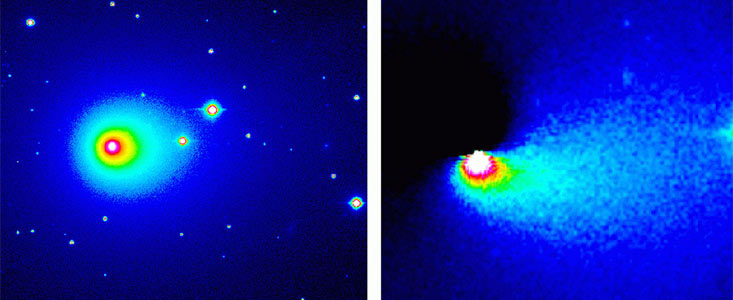Press Release
Asymmetries in the Coma of Comet C/1996 B2 (Hyakutake)
16 February 1996
This false-colour photo demonstrates the asymmetry, now apparent in the coma of Comet C/1996 B2 (Hyakutake). This comet will make a close approach to the Earth (15 million kilometres) on March 25, 1996.
The images to the left are reproductions of two CCD frames obtained with the EFOSC1 instrument at the Cassegrain focus of the ESO 3.6-metre telescope at La Silla on February 13, 1996, between 08:11 and 08:18 UT. The observations were made by Thomas Rauch, visiting astronomer from the Astrophysical Institute of the Kiel University (Germany), assisted by ESO night assistant Victor Merino. A total of four exposures were made through four standard optical filtres (U, B, V and R) with exposure times from 20 to 50 seconds; those in B and R are shown here after suitable image processing by Stefano Benetti (ESO-Chile).
Each original frame (left) covers an area of 5.2 x 5.2 arcmin; 512 x 512 pix; scale 0.61 arcsec/pix; seeing 1.1 - 1.5 arcsec; North is up and East is to the left.
The spectral intervals (B: 3900 - 4800 A; R: 6300 - 7000 A) both comprise reflected sunlight from the dust grains in the cometary coma. In addition, the B-band also includes significant emission from gaseous molecules (mostly CN, C2 and C3). The coma isophotes are elongated in the anti-sun direction (West-North-West, i.e. to the right); this is a result of the pressure exerted on the gas and dust by the sunlight.
The images to the right have been further processed in order to show the asymmetrical component of the inner coma. Note that the scales are different; look at the stars in order to compare the left and right images. The image processing was done in MIDAS by Hans Ulrich Kaeufl (ESO-Garching). There is clearly an intensity excess to the South and West of the nucleus in both colours. This is most likely because the most intensive sublimation takes place on the sunward side of the nucleus.
There is also an indication of a `spiral' structure (curving counter-clockwise from south-east over south towards west). This is probably a combination of the rotation of the nucleus and the pressure by the sunlight on the coma material. More observations are necessary to arrive at a better understanding of the geometry.
At the time of this observation, the comet was at a distance of 1.39 AU (208 million kilometres) from the Earth and 1.81 AU (271 million kilometres) from the Sun.
About the Release
| Release No.: | eso9612 |
| Legacy ID: | Photo 13/96 |
| Name: | C/1996 B2, Comet Hyakutake |
| Type: | Solar System Solar System : Interplanetary Body : Comet : Coma |
| Facility: | ESO 3.6-metre telescope |
| Instruments: | EFOSC |

